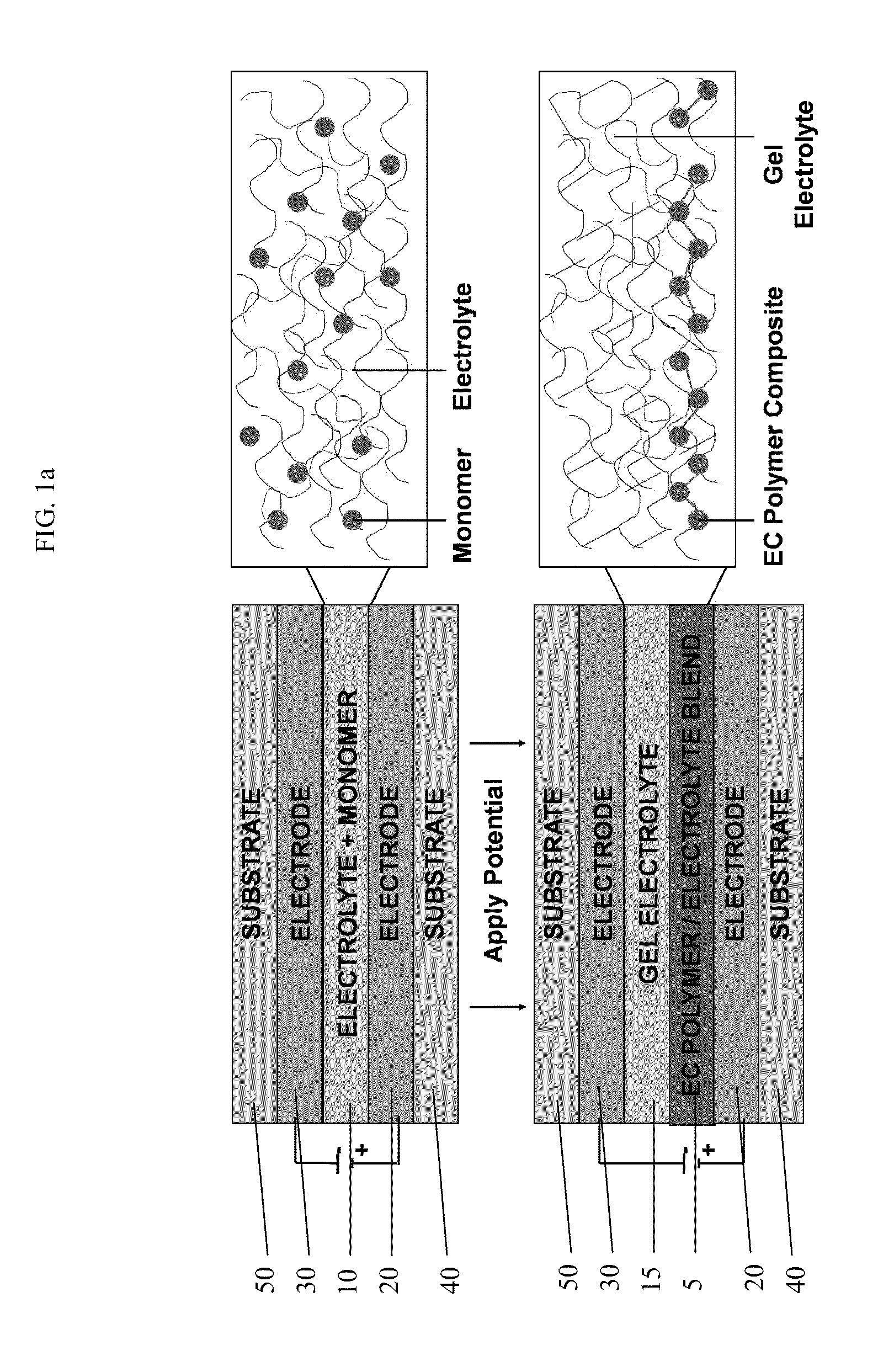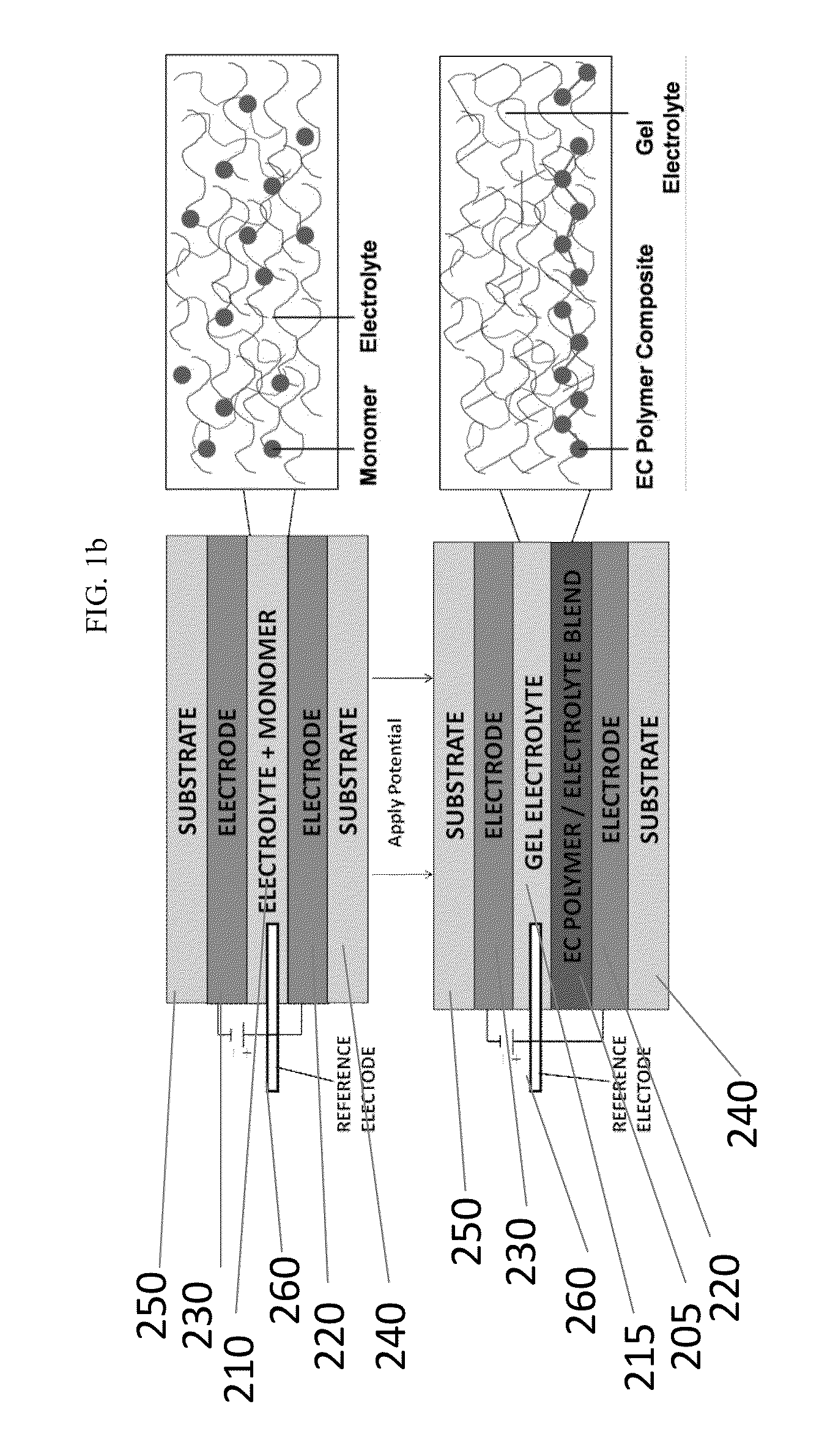Electrochromic devices prepared from the in situ formation of conjugated polymers
a technology of conjugated polymers and electrochromic devices, which is applied in the field of electrochromic devices, can solve the problems of slow switching speed, lack of color choice, and lack of cost-effective technology with the right feature characteristics
- Summary
- Abstract
- Description
- Claims
- Application Information
AI Technical Summary
Benefits of technology
Problems solved by technology
Method used
Image
Examples
example 1
Goggles Prepared Via an In Situ Polymerization of EDOT Using a Gasket-Filling Process
[0245]FIG. 3 and FIG. 4 are directed to electrochromic goggles prepared using a gasket-filling process. The electrochromic used in the goggles of FIG. 3 is prepared from a solution containing 250 mg of 3,4-ethylenedioxythiophene (EDOT), 1 g of lithium trifluoromethane sulfonate (LITRIF), 5 g of polyethylene glycol diacrylate (PEG-DA), 5 g of propylene carbonate (PC), 17.5 mg of dimethoxyphenylacetophenone (DMPAP), and 5 mg of glass beads (optional; prevents shorting of substrate electrodes). The lenses were made from PET-ITO substrate. The device can be triggered to function (polymerized) within 3-5 minutes by applying a continuous positive bias, and once finished, the switching time is within 30 seconds, often as low as 0.5-2 seconds. Copper tape leads were attached around all edges, for speed and ease of addressability. The device was placed in between two pieces of previously-formed ballistic pol...
example 2
Sunglasses Prepared Via an In Situ Polymerization of EDOT
[0247]FIG. 6A is directed to a sunglasses electrochromic device prepared using the same formula materials as in Example 1. A “cookie-cutter” approach was used to allow for the selection of a desired shape of the PET-ITO substrate for a subsequent laminated-to, process. In other embodiments, the glass / plastic material of the final sunglasses itself can be used as the substrate. The device in FIG. 6 is a single device as opposed to one where each eye is a separate device for individual control.
example 3
Sunglasses Prepared Via an In Situ Polymerization of Precursor Polymers
[0248]Device FIGS. 6B and 6C are directed to a sunglasses electrochromic device prepared using precursor polymer poly(bis-3,4-ethylenedioxythiophene[thiophene]-dioctyl silane). A PET-ITO substrate was spray-coated with a 20 mg / mL solution (in dichloromethane) of poly(bis-3,4-ethylenedioxythiophene[thiophene]-dioctyl silane). The precursor is insulating and yellow in color when applied. The device was assembled using a gel of 1 g of lithium trifluoromethane sulfonate (LITRIF), 5 g of polyethylene glycol diacrylate (PEG-DA), 5 g of propylene carbonate (PC), 17.5 mg of dimethoxyphenylacetophenone (DMPAP), and 5 mg of glass beads (optional; prevents shorting of substrate electrodes). The device was sealed using Norland Optics UV-curable adhesive and the gel electrolyte was cured at 365 nm for 5 minutes. The device was then subjected to a +3V bias for 60s to polymerize the precursor film. The device switches within 1-...
PUM
| Property | Measurement | Unit |
|---|---|---|
| haze | aaaaa | aaaaa |
| temperature | aaaaa | aaaaa |
| melting points | aaaaa | aaaaa |
Abstract
Description
Claims
Application Information
 Login to View More
Login to View More - Generate Ideas
- Intellectual Property
- Life Sciences
- Materials
- Tech Scout
- Unparalleled Data Quality
- Higher Quality Content
- 60% Fewer Hallucinations
Browse by: Latest US Patents, China's latest patents, Technical Efficacy Thesaurus, Application Domain, Technology Topic, Popular Technical Reports.
© 2025 PatSnap. All rights reserved.Legal|Privacy policy|Modern Slavery Act Transparency Statement|Sitemap|About US| Contact US: help@patsnap.com



